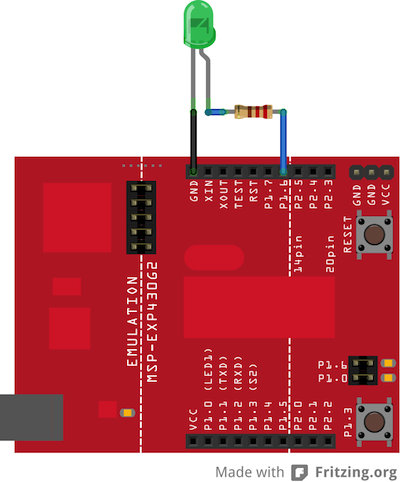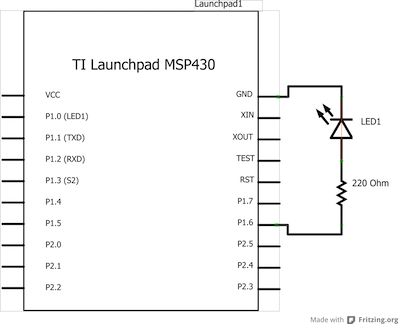Examples > Basics
Fading
This program illustrates how to fade LED ON & OFF with the help of analogWrite( ).
Hardware Required
- MSP-EXP430G2 LaunchPad
- 10k ohm resistor
- breadboard
- hook-up wire
- LED (available on-board)
Relevant Groundwork
We can fade a LED at varying brightness levels between ON & OFF. This can be done with the help of analogWrite( ). The function call to analogWrite(),will generate a steady square wave of the specified duty cycle until the next call to analogWrite( ) and write the value to the specified pin. Refer to the pin mapping guide to know the pins which can be used for analogWrite( ). In this example, we use pin 14 .
For on-board LED:No external circuitry is required, if MSP430 onboard LED is used.
For external LED:Connect the anode (the longer, positive leg) of your LED to output pin 14 on your Launchpad through a 220-ohm resistor. Connect the cathode (the shorter, negative leg) directly to ground. The circuit is as shown above.
Circuit

image developed using Fritzing. For more circuit examples, see the Fritzing project page
Schematic

Code Explanation
In set up function, After declaring pin 14 to be your ledPin, there is nothing to do in the setup() function of your code.
The analogWrite() function that you will be using in the main loop of your code requires two arguments: One telling the function which pin to write to, and one indicating what PWM value to write.
In order to fade your LED off and on, gradually increase your PWM value from 0 (all the way off) to 255 (all the way on), and then back to 0 once again to complete the cycle. In the sketch below, the PWM value is set using a variable called brightness. Each time through the loop, it increases by the value of the variable fadeAmount.
If brightness is at either extreme of its value (either 0 or 255), then fadeAmount is changed to its negative. In other words, if fadeAmount is 5, then it is set to -5. If it's -5, then it's set to 5. The next time through the loop, this change causes brightness to change direction as well.
analogWrite() can change the PWM value very fast, so the delay at the end of the sketch controls the speed of the fade.
Code
/*
Fade
This example shows how to fade an LED on pin 14
using the analogWrite() function.
This example code is in the public domain.
*/
int brightness = 0; // how bright the LED is
int fadeAmount = 5; // how many points to fade the LED by
void setup() {
// declare pin 14 to be an output:
pinMode(GREEN_LED, OUTPUT);
}
void loop() {
// set the brightness of pin 9:
analogWrite(GREEN_LED, brightness);
// change the brightness for next time through the loop:
brightness = brightness + fadeAmount;
// reverse the direction of the fading at the ends of the fade:
if (brightness == 0 || brightness == 255) {
fadeAmount = -fadeAmount ;
}
// wait for 30 milliseconds to see the dimming effect
delay(30);
}
Working Video
(Insert Video Here)Try it out:
- Fade multiple LEDs in a cool patternSee Also:
- setup()
- loop()
- analogWrite()
- int()
- for()
- PWM
- BareMinimum: The bare minimum of code needed to start an Energia sketch.
- Blink: Turn an LED on and off.
- DigitalReadSerial: Read a switch, print the state out to the Energia Serial Monitor.
- AnalogReadSerial: Read a potentiometer, print it's state out to the Energia Serial Monitor.
- Fade: Demonstrates the use of analog output to fade an LED.
- ReadAnalogVoltage : Reads an analog input and prints the voltage to the serial monitor.
Corrections, suggestions, and new documentation should be posted to the Forum.
The text of the Energia reference is licensed under a Creative Commons Attribution-ShareAlike 3.0 License. Energia reference is based on the Arduino reference. Code samples in the reference are released into the public domain.